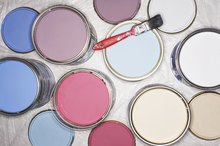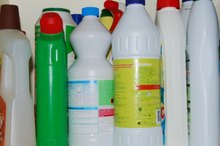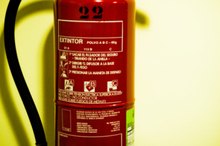Skin Problems Following Chlorine Contact
Chlorine is a nonmetallic chemical commonly used as a bleaching agent and to kill germs in swimming pools. It also is contained in products such as synthetic rubbers and pesticides. Chlorine is known for its yellowish toxic gas that is poisonous if inhaled or swallowed. This substance can also be very irritating when it's in contact with the skin.
Pool Exposure
The skin may develop a rash (irritant contact dermatitis) when it has come into contact with high amounts of chlorine such as in swimming pools or hot tubs. It may help to use lotions (hydrocortisone or calamine lotion) to relieve any itching from the rash as well as chlorine neutralizing lotions that are applied prior to entering the water to protect the skin from the possible effects of chlorine.
The symptoms associated with contact dermatitis may include itching and dry reddish patches or bumps. The rash is typically confined to the area that has been exposed to the irritant (chlorine). There may sometimes be tenderness or pain associated with the rash.
- The skin may develop a rash (irritant contact dermatitis) when it has come into contact with high amounts of chlorine such as in swimming pools or hot tubs.
- The symptoms associated with contact dermatitis may include itching and dry reddish patches or bumps.
Low Level Exposure
Itchy Skin From Chlorine
Learn More
According to the National Institutes of Health (NIH), if chlorine gets on the skin (or in the eyes) spend a minimum of 15 minutes rinsing the skin 1. Chlorine may cause irritation, burning and possible necrosis (localized death of living cells) on the surface of the skin (epidermis) or in the tissue that lies beneath.
Higher Level Exposure
The New York State Health Department says higher levels of exposure to chlorine can cause severe chemical burns or ulcerations (an inflamed lesion on the skin that may discharge fluid or pus) 2. Skin contact with liquefied chlorine can cause frostbite.The Centers for Disease Control says that when chlorine is pressurized and cooled it turns into a liquid.
Chlorine on Clothing
Skin Hazards From Pool Shock
Learn More
If you believe your skin has made contact with chlorine that was in your clothing, immediately take off the items and put them in a plastic bag. Close and seal the bag and refrain from touching it again until it can be properly discarded. Use a generous amount of soap and water to wash off your skin. If you wear eyeglasses, remove and thoroughly clean them before putting them back on.
- If you believe your skin has made contact with chlorine that was in your clothing, immediately take off the items and put them in a plastic bag.
Related Articles
References
- National Institute of Health
- New York Health Department
- Novak-Bilić G, Vučić M, Japundžić I, Meštrović-Štefekov J, Stanić-Duktaj S, Lugović-Mihić L. Irritant and allergic contact dermatitis - skin lesion characteristics. Acta Clin Croat. 2018;57(4):713–720.
- Centers for Disease Control and Prevention. Rashes. Reviewed May 4, 2016.
- Centers for Disease Control and Prevention. Parasites - Cercarial Dermatitis (also known as Swimmer's Itch). Reviewed October 22, 2018.
- Rossetto AL, Da Silveira FL, Morandini AC, Haddad V, Resgalla C. Seabather's eruption: report of fourteen cases. An Acad Bras Cienc. 2015;87(1):431-6. doi:10.1590/0001-3765201520130468
- Chaumont A, Voisin C, Sardella A, Bernard A. "Interactions Between Domestic Water Hardness, Infant Swimming and Atopy in the Development of Childhood Eczema." Environmental Research. 2012 Jul;116:52-7. DOI: 10.1016/j.envres.2012.04.013.
- Gomà A, de Lluis R, Roca-Ferrer J, Lafuente J, Picado C. "Respiratory, Ocular and Skin Health in Recreational and Competitive Swimmers: Beneficial Effect of a New Method to Reduce Chlorine Oxidant Dervatives." Environmental Research. 2017 Jan;152:315-321. DOI: 10.1016/j.envres.2016.10.030.
- Khodaee M, Edelman GT, Spittler J, et. al. "Medical Care for Swimmers." Sports Medicine Open. 2016 Dec; 2: 27. DOI: 10.1186/s40798-016-0051-2.
- Salvaggio HL, Scheman AJ, Chamlin SL. "Shock Treatment: Swimming Pool Contact Dermatitis." Pediatric Dermatology. 2013 Jul-Aug;30(4):494-5. DOI: 10.1111/pde.12017.
Writer Bio
Karen Hellesvig-Gaskell is a broadcast journalist who began writing professionally in 1980. Her writing focuses on parenting and health, and has appeared in “Spirituality & Health Magazine" and “Essential Wellness.” Hellesvig-Gaskell has worked with autistic children at the Fraser School in Minneapolis and as a child care assistant for toddlers and preschoolers at the International School of Minnesota, Eden Prairie.









